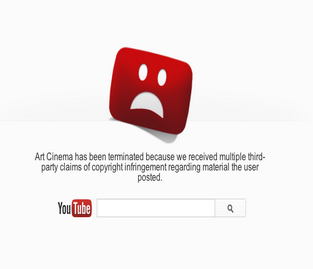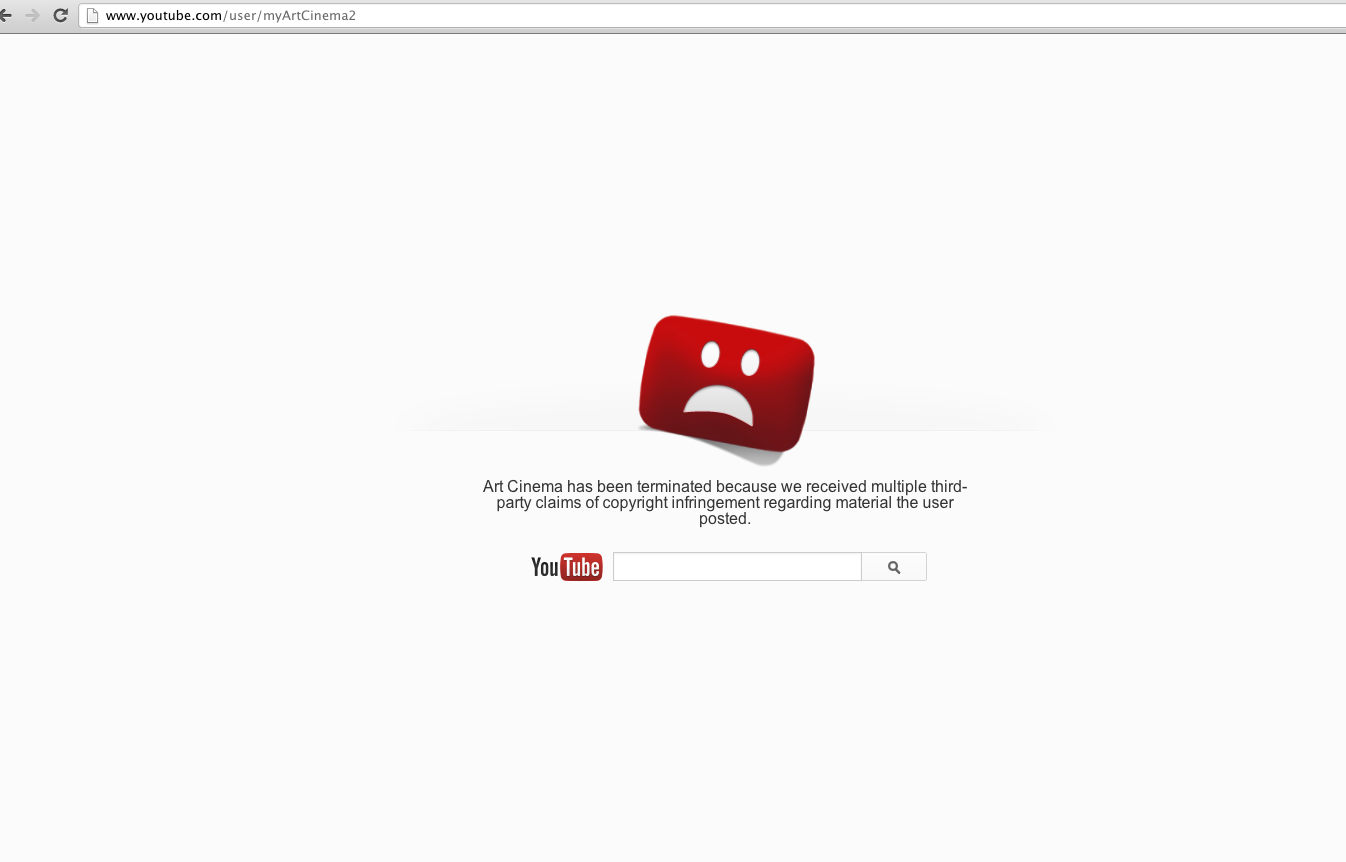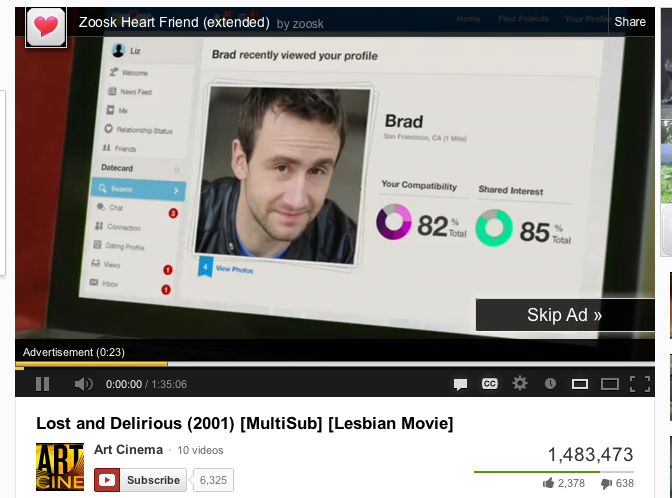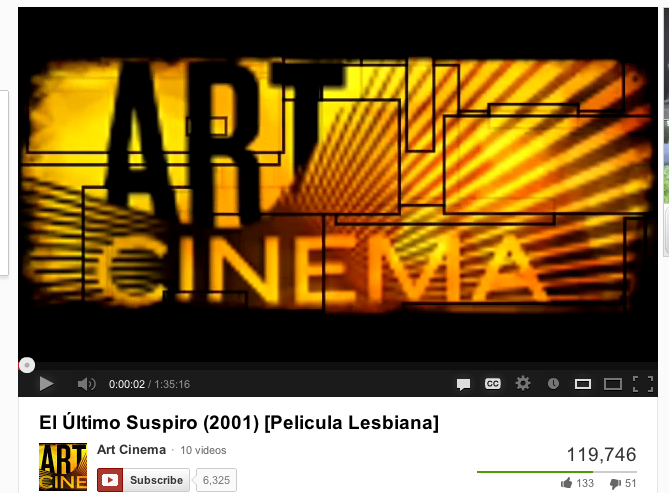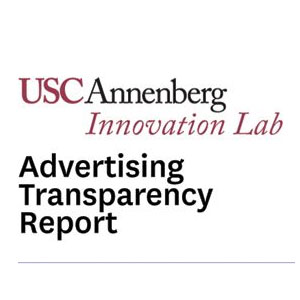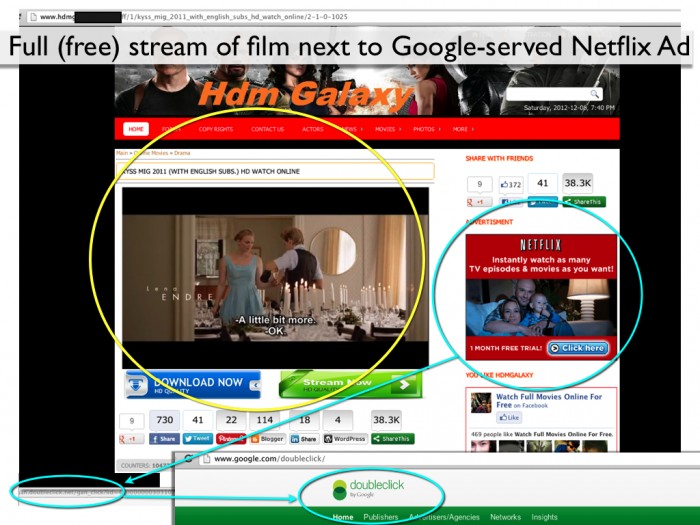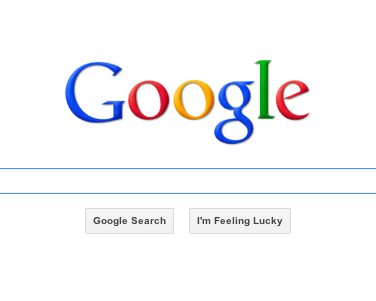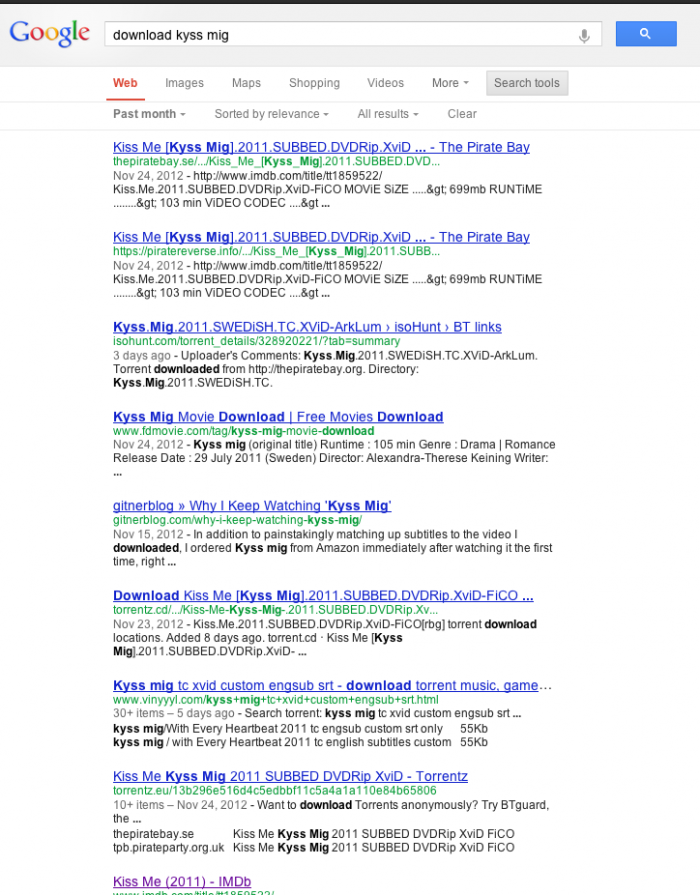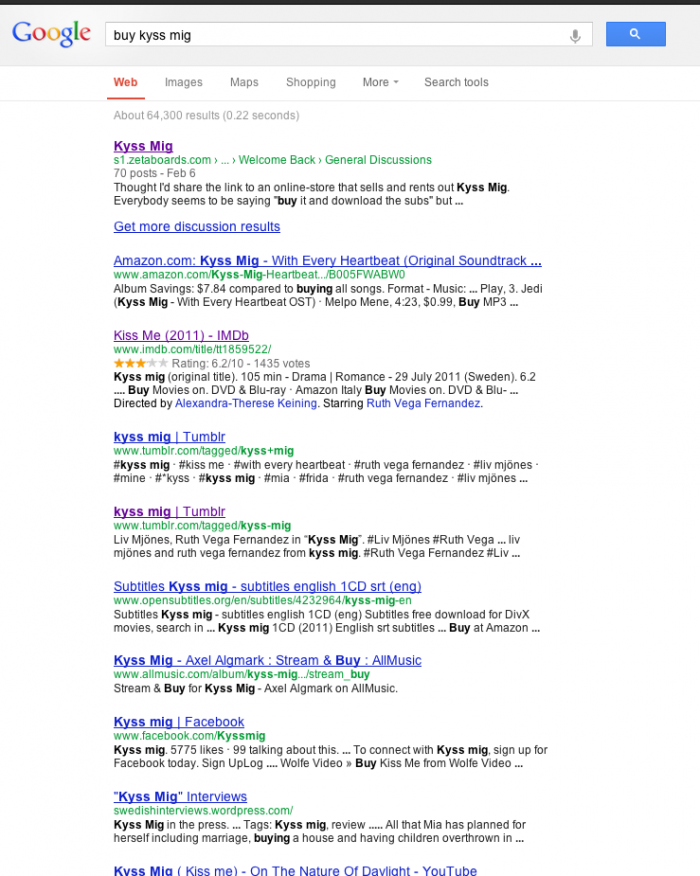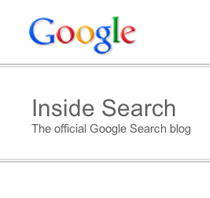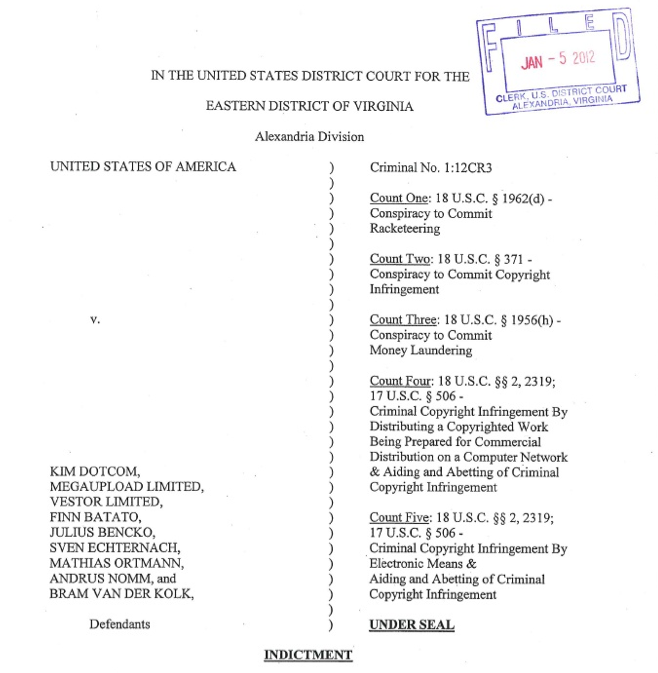If you read my earlier post describing how a YouTube user monetized pirated films , you’ll appreciate this update:
Youtube Allows Pirate “Partners” to Profit From Illegal Movie Uploads
 I was on YouTube recently and came across another, not so surprising, downside to their content monetization. At first I’d noticed some movie trailers that were uploaded, claimed, and monetized by entities other than the studios/rights holders. Now it’s not surprising that folks upload trailers that aren’t theirs, claim it and make money off it. However, it doesn’t stop there.
I was on YouTube recently and came across another, not so surprising, downside to their content monetization. At first I’d noticed some movie trailers that were uploaded, claimed, and monetized by entities other than the studios/rights holders. Now it’s not surprising that folks upload trailers that aren’t theirs, claim it and make money off it. However, it doesn’t stop there.
How about uploading an entire movie and earning money off it even if you don’t own the rights? Well, on YouTube it’s apparently pretty easy. Here’s an example of a Canadian feature film called “Lost and Delirious” that I discovered on YouTube—the entire film, all 95 minutes of it, conveniently offering subtitle options in multiple languages. Take your pick Czech, French, German, English, Portuguese, Spanish and Turkish…
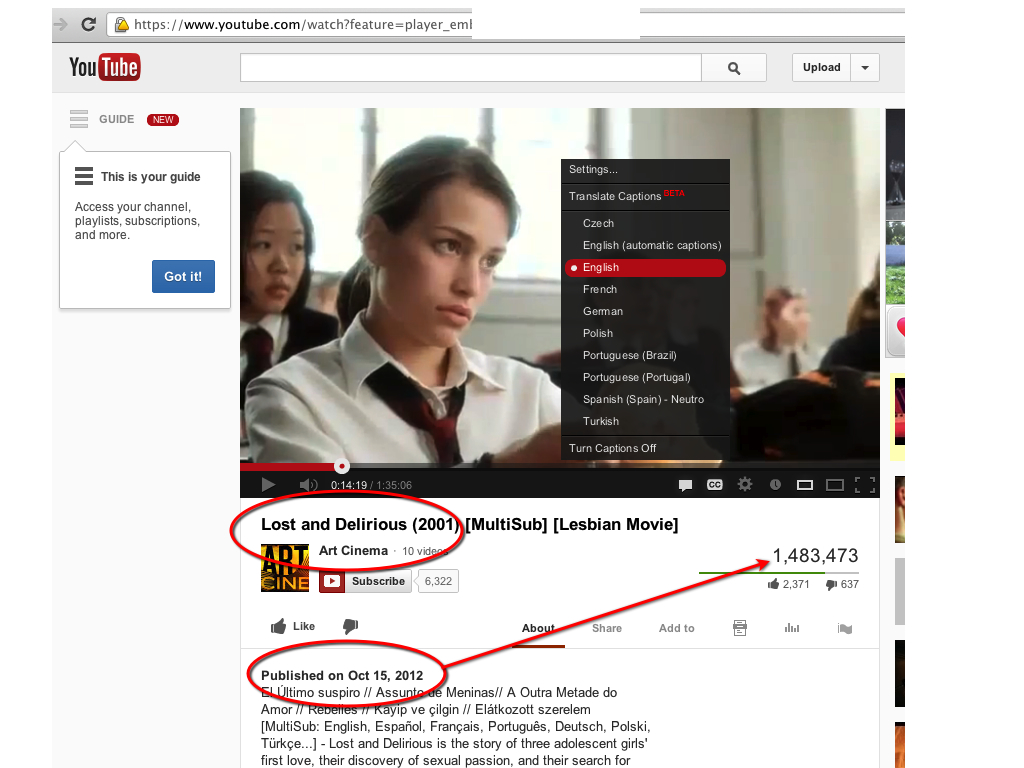
Full stream of “Lost and Delirious” complete with subtitles in multiple languages monetized on YouTube by someone other than copyright holder.
When I checked to see what entity “claimed” the film I found that it wasn’t the director Lea Pool or the studio that had claimed it. It was claimed by YouTube user __u1DkXdYlQ6__. It’s not a user name per se, the actual uploader seems to be attached to a channel aptly titled “Art Cinema” with the YouTube user name: myArtCinema3. However, by the looks of it, it appears that __u1DkXdYlQ6__ is the “Partner” (i.e. monetization account) that has “claimed” the film on behalf of “Art Cinema.” Since there is advertising on this upload, one can assume that the clip was indeed claimed for the purpose of monetizing it.
Here’s the ownership information for this movie viewed via my CMS dashboard. The user “asserts ownership” worldwide. I wonder what the film’s legit distributor thinks about that claim?
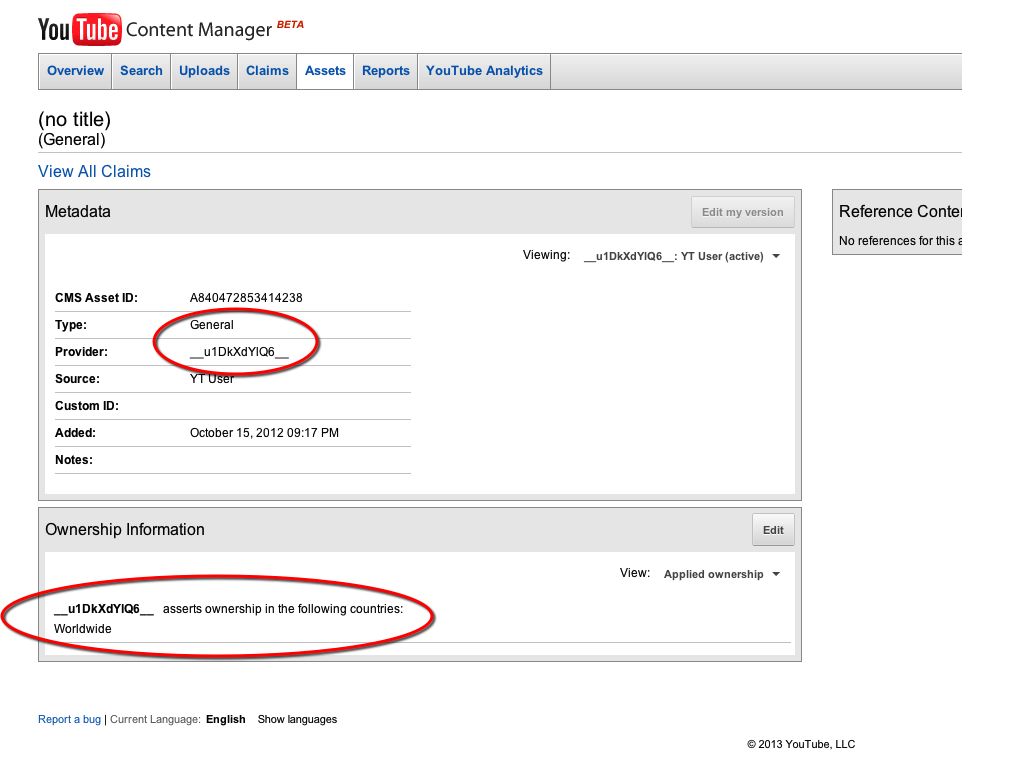
Notice that the film was uploaded on October 15th, 2012 and in less than four months, has already attracted nearly 1.5 million views. What that means is lots of ad money for YouTube/Google and lots of money for the pirate who uploaded the film. The filmmaker and her production company apparently get nothing.
This is not an isolated example. It appears that this same YouTube user has uploaded other complete films, using several accounts, with varying degrees of success. In November, “myartcinema4” uploaded and claimed another popular indie film from the 90s, “The Incredibly True Adventures of Two Girls in Love.” It’s already attracted more than 2 million views, worth nearly $6,000, a tidy pirate profit.*
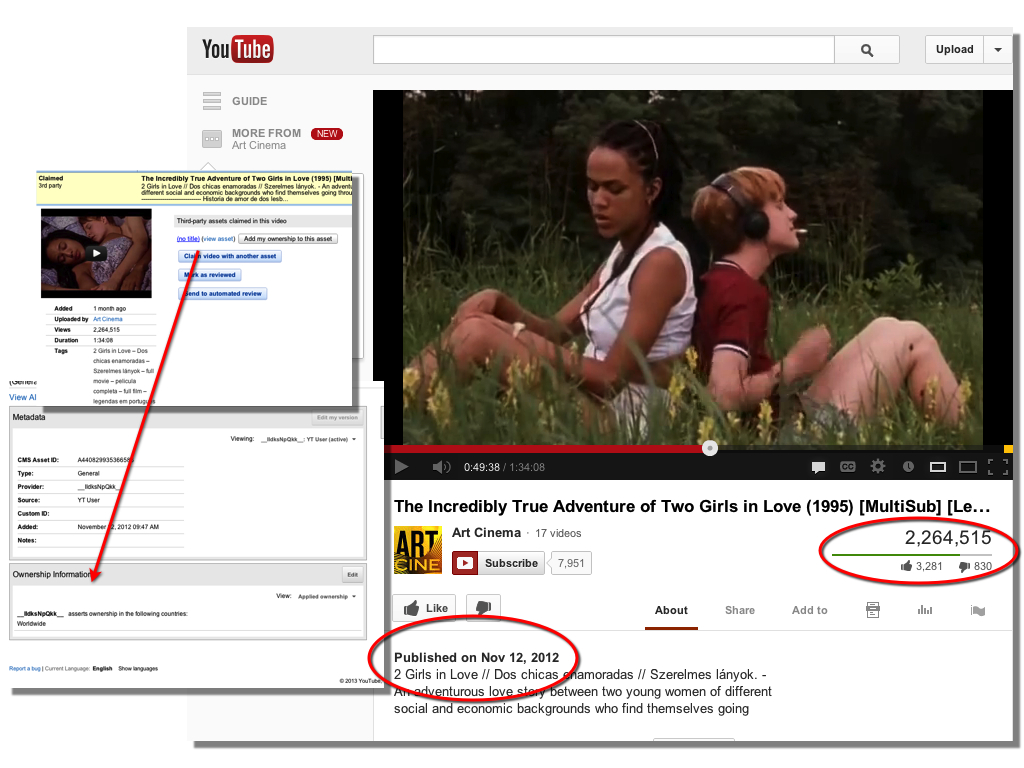
YouTube user “artcinema4” has uploaded and “claimed” this film. Uploaded in November it’s already attracted more than 2 million views.
Another upload “Antonia’s Line”, has attracted more than 400,000 views but can’t be monetized since it’s labeled “age restricted” under YouTube community guidelines (meaning some user tagged it, probably for sexual content).
“Lost and Delirious,” also rated “R,” seems to have slipped under the “community” censorship radar–for the time being anyway, but it’s probably why this user uploaded a duplicate copy of the film. In case the first cash cow gets tagged as having “age restricted” content, the second copy can fill viewer demand and earn clicks and cash for this industrious pirate’s coffers.
Uploaded a month later on November 15th, this second version has garnered more than 119,000 views. Adding the two together, that’s more than 1.6 million total views. It’s impossible to know exactly how much income that generates, but it’s likely somewhere around $3,000 so far.
Overall, not a bad payday considering the uploader didn’t do a lick of work…well, unless you count uploading the films and, in profound bit of hubris, adding a customized “art cinema” graphic (below) to the opening credits of the stolen films. Of course we’ll also never know how much YouTube/Google makes on these illegal uploads since the company is notoriously opaque when it comes to providing specifics on its billions in advertising income. I’ve attempted to contact a representative from YouTube for comment on this story and will update if any response is forthcoming.
It also appears that this uploader has created a number of other similarly theme YouTube accounts, four of which (created in September, October and November 2012) under the user names: myArtCinema, myArtCinema2, myArtCinema3, and myArtCinema4. All four “channels” offer uploads of complete films, some of which are older foreign titles and may be in the public domain. The uploaded films seem to be linked to various YouTube “Partner” accounts including (__OkhXVt6c-7__) and (__BnxrHCbbK2__), but I suspect they all link back to the same individual, or group of individuals. Though I haven’t yet been able to confirm this with YouTube, given the way the channels are presented, organized and linked, it’s hard not to believe otherwise.
There’s also an account, presumably by the same individual, with the moniker artcinema4. Not sure what happened to artcinema1, 2, and 3…but I would guess they were removed due to repeated copyright infringement. This thief certainly believes in multiple layers of redundancy to protect his/her scheme.
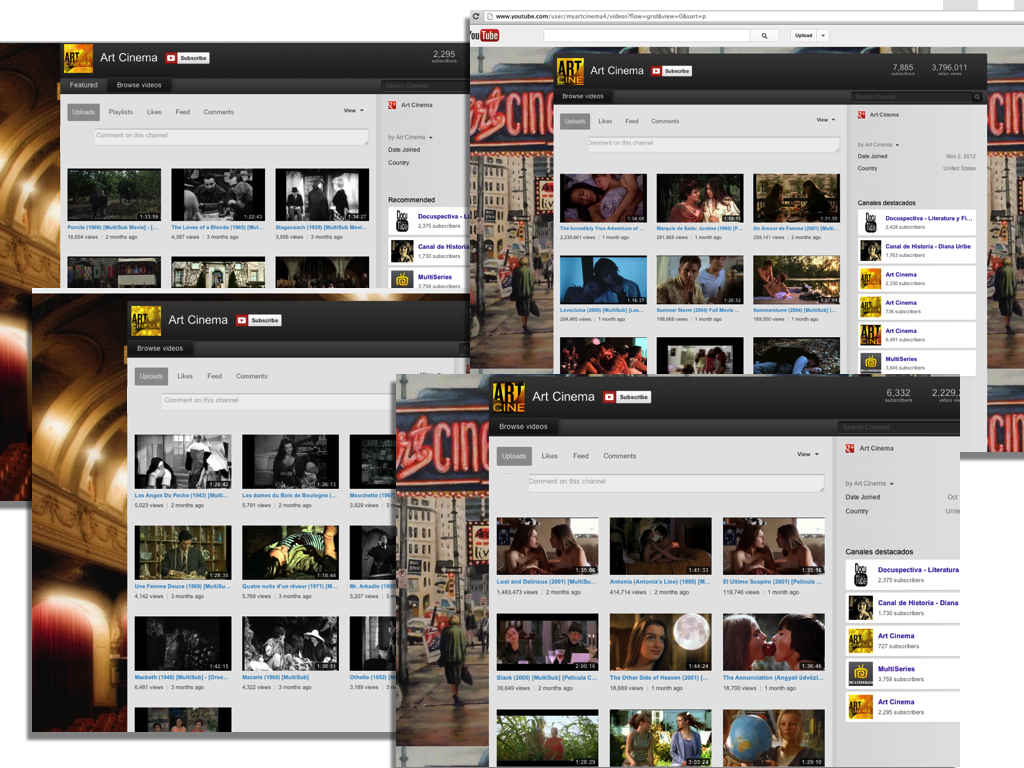
This YouTube pirate has opened multiple accounts using variations on the moniker “art cinema” –all feature full-length movies monetized with advertising
One might ask what YouTube should do about this situation? After all, the films’ distributors don’t seem to have set up Content ID matching to protect these title, or perhaps they just slipped through (Content ID matching is not infallible). Should the onus be on them to prevent this kind of theft–theft that benefits the uploader and the host? By allowing uploads for longer content, including feature length films, YouTube has opened the door to this activity.
I’m all for allowing users to upload works that exceed 20 minutes in length, as long as it’s their own work. For uploads with running times longer than 20 minutes, why not put the burden on YouTube users to prove that they, in fact, own the rights to such material before it’s approved for upload? Of course, until recently, YouTube restricted upload lengths for most users, so pirates would often break films into multiple, 10-minute parts….still piracy, but at least that format created a disincentive to watch a pirated movie.
As of now, YouTube seems to place few obstacles in the path of pirates and their profits. Let’s also not forget that it’s the lure of profits, not altruism, that encourages users like “myArtCinema” to upload this type of stolen content in the first place. This is but one example of a very calculated, and all too common crime. A crime, that for the time being, has little apparent risk and much potential reward. Perhaps the films’ rights holders will go to court and ask for the income to which they are entitled. I hope so.
*My income estimate is based on a similar title that earned $700+ for 250,000 hits on YouTube. Google/YouTube does not release specific information regarding Youtube monetization income.
This post was first published on my blog Vox Indie.
More Evidence Ad Dollars Support Piracy
 I was happy to see today’s “Advertising Transparency Report” issued by USC’s Annenberg Innovation Lab that documents the flow of ad dollars from legit companies to pirate websites. According to the report:
I was happy to see today’s “Advertising Transparency Report” issued by USC’s Annenberg Innovation Lab that documents the flow of ad dollars from legit companies to pirate websites. According to the report:
…many major brands are not aware that they are in fact the key source of funds for the Piracy industry, it is the goal of this “transparency report” to aid in helping these brands steer their ad dollars away from sites that exploit film, TV and music artists for what appears to be criminal gain.
Though I applaud the report’s overall findings that ad dollars incentivize and subsidize online piracy, I question the conclusion that “major brands” were not “aware that they are in fact the key source of funds for the Piracy industry.” As I’ve noted in the past, advertisers are usually extremely careful, and cognizant, about where their advertising appears. Why the sudden lack of concern for their ad placements online?
More than two years ago I was inspired to start this blog to document this very issue. As an indie filmmaker facing piracy, it didn’t take me long to recognize there was a major link between ad dollars and the growth of online piracy. I attempted to answer the question “Who Profits from Piracy?” From my introduction:
Online piracy isn’t about altruism, it’s about income. Today’s technology allows web pirates to steal content and monetize that content with a click of a mouse. Meanwhile, “legit” companies encourage and facilitate this theft while also profiting from it (ad service providers, advertisers and payment processors). The time has come for reasonable measures to be taken to discourage this theft. Content creators and consumers will benefit. Only the pirates and those who profit from their theft will lose.
I wrote that in June of 2010. Yet here we are, nearly three years later, and what has changed? Reading the latest news, it appears the answer is, “not much.” According to the LA Times Levi’s was said to surprised by the report’s findings and contacted their ad agency and instructed them to take immediate action to prevent their ads from appear on illegal file-sharing websites. Was Levi’s really surprised–and more important–will other companies finally follow suit? Forgive me if I remain skeptical. The fact that ad dollars fuel online piracy is not news.
This video (found on the introduction to this blog) is based on a presentation I gave at Canadian Music Week’s Global Forum in the spring of 2011. It documents my journey through the landscape of online piracy and its undeniable link to advertising revenues. Follow the money…
Some progress has been made since then, most notably, last year’s takedown of Megaupload–the Big Daddy of illegal file sharing. It’s worth noting at this juncture, that Megaupload’s millions were generated in large measure by ad dollars (as well as subscription fees). Numerous copycat websites have sprung up to fill the void left by Megaupload, and they too depend business models sustained by advertising dollars. With the demise of legislative efforts to address this black market, content creators are left with little recourse.
Back in 2010 I attempted to contact advertisers like Netflix and others whose ads were, and still are, ubiquitous on numerous illegal download sites. Most of my efforts were ignored, but on July of 2010, after NPR aired a story about my blog on “All Things Considered” that mentioned Netflix ads; I received an email from Steve Swasey, their VP of Corporate Communications who wrote the following:
Netflix does not tolerate piracy and we do not support pirate sites. We are very clear with our advertising agencies and affiliate partners about this. Sometimes ads slip through and when this happens, we react swiftly and decisively, removing the ad and not paying the site.
Again, that was over two years ago. Yet here’s an example of a Netflix ad (served by Google) on a pirate site I here last month. The ad appears alongside an embedded, full stream of a pirated film, “Kyss Mig.” As I said, not much seems to have changed.
We’ll see if this latest report from Annenberg precipitates real change. I did take heart by looking at the results of an unofficial poll that accompanied the LA Times piece asking readers: “Should brands avoid advertising on so-called pirate sites?” As of now, 63% said yes, while 37% said no. Perhaps there reason to hope, that at long last, the balance could shift away from an insidious equation where everyone, except the actual content creators, make money from online theft. When presented with clear and tangible evidence, the public seems to be on the side of creators. Yet in this game, for any real progress to be made, the ball remains squarely in the advertisers’ court.
Should More Artists Speak Out Against Piracy?
 Today I came across a blog post published by Chris Kornelis in the Seattle Weekly, “It’s Time for Artists to Fight Piracy as Vigorously as They’ve Challenged Pandora.” Kornelis asserts,”One of the year’s most peculiar yet persistent music-industry trends has been the way legitimate forms of digital-music consumption have been vilified more strongly than illegitimate ones.”
Today I came across a blog post published by Chris Kornelis in the Seattle Weekly, “It’s Time for Artists to Fight Piracy as Vigorously as They’ve Challenged Pandora.” Kornelis asserts,”One of the year’s most peculiar yet persistent music-industry trends has been the way legitimate forms of digital-music consumption have been vilified more strongly than illegitimate ones.”
As an indie artist (filmmaker) who’s made a point of fighting piracy, the headline caught me somewhat off guard. Of course we speak out. But as I read his piece, I found myself in agreement with his overall message. Last month congressional hearings were held over proposed legislation that would change royalty formulas for internet radio services such as Pandora. Labeled the “Internet Radio Fairness Act” the bill was roundly criticized by those in the music industry, artists and publishers alike. After a massive outcry, including a protest letter signed by a diverse group of well-known recording artists and bands including Rihanna, Katy Perry, Maroon 5, Alabama and CeeLo Green, among others–the bill went down in flames, at least for now.
In the wake of that defeat, and given the influence and unity displayed by a coalition of artists, Kornelis asks why more artists don’t routinely speak out and educate their fans about negative impact online piracy has on their (our) livelihoods and art. He notes that a few artists have spoken out and “…when they do, they are eviscerated, as Lars Ulrich, Lily Allen, or Duff McKagan will tell you…” He then challenges all of us to do more.
…it’s time for artists to band together to set the story straight. Don’t leave it to the few brave enough to speak strongly on the matter. There needs to be a large, coordinated effort by bands big and small to tell their story–to sign a letter to fans explaining how devastating piracy is to their ability to make music for a living (or at all). “The voice of that community is clearly the most important,” says Chris Ruen, author of the recent book, Freeloading: How Our Insatiable Hunger for Free Content Starves Creativity. “Artists need to raise their voices.”
Indeed. Whether musicians, filmmakers, writers, journalists, artists or photographers–we all need to speak up, and speak out. If we can use our collective voices to educate, and explain what’s at stake for creators and consumers, the more inroads we are likely to make. As Benjamin Franklin aptly noted, “We must indeed all hang together, or, most assuredly, we shall all hang separately.”
-This post was originally published on my other blog, Vox Indie (voxindie.org).
IP and Instagram-a Teaching Moment Perhaps?
I had to shake my head when I saw the outraged reaction to Declan McCullagh’s story on CNET.com about changes made Instagram’s “Terms of Service” that supposedly now give the popular Facebook-owned online photo-sharing service the right to “sell users’ photos without payment or notification.” According to McCullagh:
Instagram said today that it has the perpetual right to sell users’ photographs without payment or notification, a dramatic policy shift that quickly sparked a public outcry.
The new intellectual property policy, which takes effect on January 16, comes three months after Facebook completed its acquisition of the popular photo-sharing site. Unless Instagram users delete their accounts before the January deadline, they cannot opt out.
Nowadays social media sites are constantly tweaking their privacy and usage policies, so that’s nothing new. What struck me, however, was how many of the site’s subscribers were suddenly discussing, and expressing concerns about, protecting copyright. Suddenly the concept of protecting IP seems to matter–well, at least when it comes protecting their IP.
In comments responding to McCullagh’s CNET piece, one poster admonished Instagram saying: “You DO NOT have permission to use my stuff just because it’s hosted on your servers.” I agree, but Megaupload’s Kim Dotcom would likely take the opposing view.
Another posted this: “My photos will not sell without my knowledge and compensation. I spend time on my pictures.” For the record, this is essentially what content creators have been saying for a long time in rebuttal to claims that online piracy is OK.
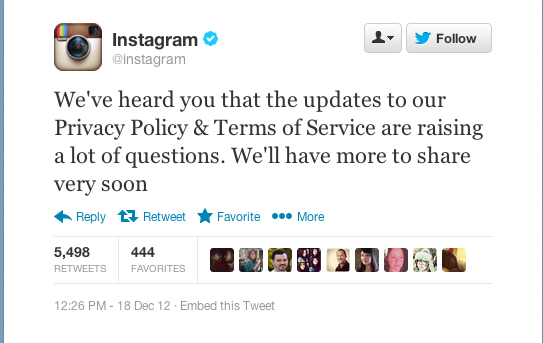 Whatever happens with Instagram’s “Terms of Service” (the company already appears to be attempting to clarify them) I think we should take advantage of this dust-up as a possible teaching moment. Copyright is important to creators, small and large, on Instagram and across the web. Perhaps when people realize what’s at stake with their own creations, they will better appreciate what’s at stake when it comes to the creative rights of others.
Whatever happens with Instagram’s “Terms of Service” (the company already appears to be attempting to clarify them) I think we should take advantage of this dust-up as a possible teaching moment. Copyright is important to creators, small and large, on Instagram and across the web. Perhaps when people realize what’s at stake with their own creations, they will better appreciate what’s at stake when it comes to the creative rights of others.
Google Search #FAIL Means More $$$ for Them
Not to beat a dead horse, but surprise, surprise….I did a Google search this morning to see how easy it would be to find download links for “Kyss Mig,” a recently released Swedish indie film. I used Google to search for “download kyss mig” and….oops, so much for Google’s new search algorithm that’s supposed to penalize (reported) pirate sites. Why am I not surprised that The Pirate Bay result tops the list?
Maybe if I use the less pirate-centric term “watch” instead of “download” I’ll have better luck finding a legit source? Um, well, no, guess that won’t work either. Once again the top search results are sites notorious for linking to pirated films. Even more maddening is what I discovered when I clicked the first link…
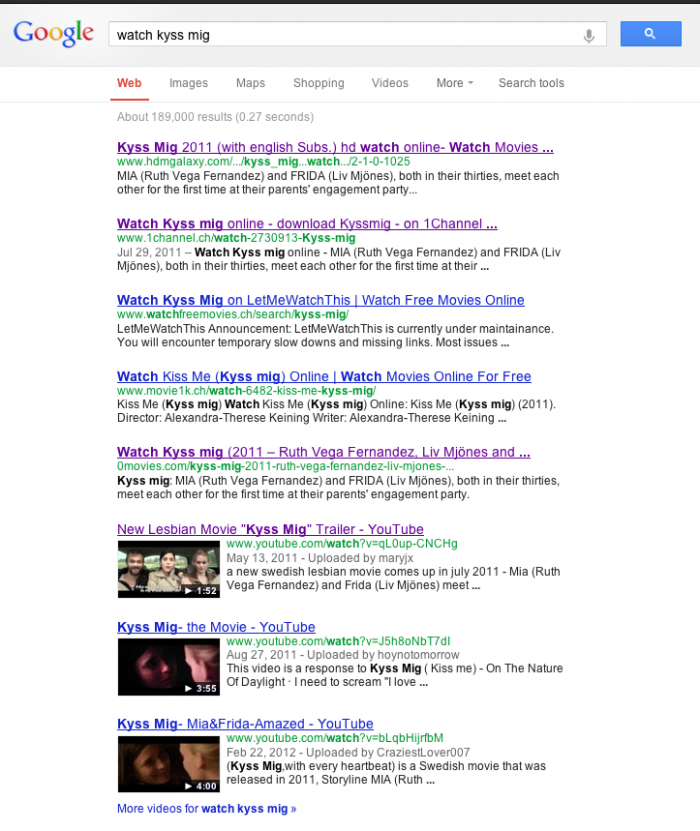 Not only did I find the full film streaming (for free) online but right beside was a Netflix advertisement. BTW I watched the first 10 minutes to double check that it was the actual film and reported it to the film’s distributor so they could have it removed. When I checked the source of the ad I found it led me back to “doubleclick.net” a Google-owned company. Perhaps this is how Google expects users to find legit copies of the film? After all, Kyss Mig does stream on Netflix….kind of a roundabout way to find the film when I can watch it right here, right now for free! Of course Google makes money from the ad either way (as does the pirate website) so what do they care? Hmmm, perhaps the Google ad placement has something to do with why this pirate site is comes up first in search results? Not to don my tin foil hat but….
Not only did I find the full film streaming (for free) online but right beside was a Netflix advertisement. BTW I watched the first 10 minutes to double check that it was the actual film and reported it to the film’s distributor so they could have it removed. When I checked the source of the ad I found it led me back to “doubleclick.net” a Google-owned company. Perhaps this is how Google expects users to find legit copies of the film? After all, Kyss Mig does stream on Netflix….kind of a roundabout way to find the film when I can watch it right here, right now for free! Of course Google makes money from the ad either way (as does the pirate website) so what do they care? Hmmm, perhaps the Google ad placement has something to do with why this pirate site is comes up first in search results? Not to don my tin foil hat but….
I guess I’m going to have to be a good girl and use the search terms “buy Kiss Mig.” Only then am I given results that lead me to legit options.
Update: Since I notified the distributor that the film was available via this pirate it’s not longer available. Too bad I can’t say the same for the website itself.
Google changes search ranking algorithm to target pirate websites
 In a move that’s long overdue, Google has announced a change to the search algorithm it uses to “rank” websites listed in search results, lowering the ranking of the most egregious pirate sites. In a posting on their “Inside Search” blog Amit Singhal explains the move:
In a move that’s long overdue, Google has announced a change to the search algorithm it uses to “rank” websites listed in search results, lowering the ranking of the most egregious pirate sites. In a posting on their “Inside Search” blog Amit Singhal explains the move:
We aim to provide a great experience for our users and have developed over 200 signals to ensure our search algorithms deliver the best possible results. Starting next week, we will begin taking into account a new signal in our rankings: the number of valid copyright removal notices we receive for any given site. Sites with high numbers of removal notices may appear lower in our results. This ranking change should help users find legitimate, quality sources of content more easily—whether it’s a song previewed on NPR’s music website, a TV show on Hulu or new music streamed from Spotify.
This is good news for content creators everywhere and reflects another positive step on the part of legitimate business to delegitimize those trafficking in stolen goods. PayPal recently announced it was severing its ties to various pirate websites and now Google is revising the way it ranks sites. Certainly this won’t end piracy, but it will direct the casual consumer to legitimate sites where they can find what they want for a reasonable price and compensate the creator in the process.
With this latest announcement there appears to be hope that we can gradually transform on the online black market that drives today’s piracy into a legitimate one that can offer both consumers and creators the choices they seek. Consumers can find and access content they want it for a reasonable price, while creators can distribute their work efficiently and economically throughout the world. It helps level the online playing field–and is a win, win for us all. Many have correctly pointed out that Youtube results aren’t included in their ranking changes despite the fact Youtube undoubtedly receives a huge number of DMCA notices. While Youtube does offer rights holders a Content Management System as a means to protect and control content, it’s an imperfect and buggy system at best.
Next up on Google’s agenda should be its own house starting with the thousands of Blogger-hosted websites that offer nothing but pirated material (sort of like Filestube.com, but shinier).
The Trichordist’s David Lowery on the cost of “free culture”
 The Trichordist “Artists for an Ethical Internet” blog recently featured an eloquent piece by musician David Lowery written in response to an NPR blog post by Emily White. Anyone interested in the issue of creator’s rights should read and share this piece. It speaks for itself-read it here.
The Trichordist “Artists for an Ethical Internet” blog recently featured an eloquent piece by musician David Lowery written in response to an NPR blog post by Emily White. Anyone interested in the issue of creator’s rights should read and share this piece. It speaks for itself-read it here.
Recently Emily White, an intern at NPR All Songs Considered and GM of what appears to be her college radio station, wrote a post on the NPR blog in which she acknowledged that while she had 11,000 songs in her music library, she’s only paid for 15 CDs in her life. Our intention is not to embarrass or shame her. We believe young people like Emily White who are fully engaged in the music scene are the artist’s biggest allies. We also believe–for reasons we’ll get into–that she has been badly misinformed by the Free Culture movement. We only ask the opportunity to present a countervailing viewpoint.
Megaupload’s do-si-do around the DMCA
 If you read the 70 page federal indictment against notorious pirate cyberlocker website Megaupload, you will find this charge on page 10, section 22:
If you read the 70 page federal indictment against notorious pirate cyberlocker website Megaupload, you will find this charge on page 10, section 22:
When a file is being uploaded to Megaupload.com, the Conspiracy’s automated system calculates a unique identifier for the file (called a “MD5 hash”) that is generated using a mathematical algorithm. If, after the MD5 hash calculation, the system determines that the uploading file already exists on a server controlled by the Mega Conspiracy, Megaupload.com does not reproduce a second copy of the file on that server. Instead, the system provides a newand unique URL link to the new user that is pointed to the original file already present on the server. If there is more than one URL link to a file, then any attempt by the copyright holder to terminate access to the file using the Abuse Tool or other DMCA takedown request will fail because the additional access links will continue to be available.
During my dealings with Megaupload over this past year and a half I’d long suspected as much. Time after time, I’d remove links using Megaupload’s content management tool only to see a duplicate file reappear (with a new link) minutes later. Of course, unlike federal authorities, I did not have access to the actual content residing on Megaupload’s servers, so I couldn’t really prove it.
This past fall while I was researching a pirate blog that offered illegal downloads to LGBT films, I saw that the film “Kyss Mig” was being pirated. Since it’s a film distributed by the same company (Wolfe Video) that distributes our film I notified them of the infringing link. A DMCA notice was sent and, as expected, the link was disabled. However, when I went back to the website the following day I noticed that the disabled link had been replaced by a new one. That led me to again notify Wolfe and the exercise in futility was repeated. A few days later I noticed that the link was alive yet again, but the blog owner had changed things up (to protect her download) and the link now took me to an intermediate site “undeadlink.com.”
Essentially the site offered a convenient way to regenerate links to supposedly “dead” files on Megaupload (and apparently Fileserve). If Megaupload had actually removed the infringing file when it was originally reported, this wouldn’t have been an option. However, because Megaupload apparently did exactly what is spelled out in the indictment, it was very possible (and efficient). When I discovered what was going on last fall, and that it verified my suspicions, I decided to record the process. This video documents what I found.
Megaupload Unmasked from fastgirlfilms on Vimeo.
For more on this issue, check out Terry Hart’s excellent post on his blog Copyhype.com: Megaupload and the DMCA
Congress cowers, while pirates get busy to protect their booty
 With established pirate hives (AKA cyberlockers) imploding, online pirate entrepreneurs are working quickly to develop new ways to keep the pirate booty flowing into their bank accounts.
With established pirate hives (AKA cyberlockers) imploding, online pirate entrepreneurs are working quickly to develop new ways to keep the pirate booty flowing into their bank accounts.
Just today I received this email announcing “the next big thing” for these black market online bootleggers, a new website coming soon “made for pirates by pirates.”
With pirates busy coming up with alternatives to Megaupload and other newly defunct cyberlockers, isn’t it time Congress gets busy to figure out effective ways to tackle this issue once and for all? Piracy for profit is a problem that won’t disappear by wishing it away. Piracy is a crime that apparently does, and will continue to pay unless action is taken to stop it.

